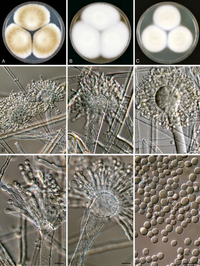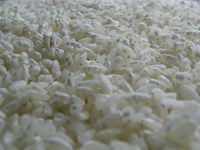Aspergillus oryzae
Aspergillus oryzae is a filamentous fungus, or mold, that is used in East Asian (particularly Japanese and Chinese) food production, such as in soybean fermentation. A. oryzae is utilized in solid-state cultivation (SSC), which is a form of fermentation in a solid rather than a liquid state. This fungi is essential to the fermentation processses because of its ability to secrete large amounts of various degrading enzymes, [4]

Classification
Higher Order Taxa
Eukarya; Fungi; Eurotiomycetes; Eurotiales; Tricocomaceae
Species
|
NCBI: A. oryzae Taxonomy |
Aspergillus oryzae
Genome
The full genome of A. oryzae RIB40 contains eight chromosomes and the mitochondrion (which is circular, rather than linear) and is estimated to be 37.6μb, or 37,878,829 bp, in size.[5] It contains 12,074 genes, and is 7-9μb longer (or 25-30% larger) than other members of the Aspergillus genus, namely the species A. nidulans and A. fumigates. A. oryzae's linear genome is made up of 48.25% GC-content, or guanine-cytosine content, which is an indicator of a higher melting point. There are 12,084 ORFs (open reading frames) within the genome, which may potentially code for essential proteins or peptides. Coding regions account for 44.02% of the genome, whereas there are only 7.48% intronic regions. Additionally, the A. oryzae genome contains 270 tRNA genes, and only 3 rRNA genes.[6]
When comparing the three Aspergillus species, it was found that in A. oryzaea combination of syntenic blocks derived from a singular ancestral region and blocks specific to A. oryzae arranged mosaically comprised the full genome. The A. oryzae-specific sequence codes for metabolite synthesis and specific gene expansion for secreting hydrolytic enzymes when used in SSF, or solid-state fermentation, which makes it such an effective microbe in fermentation processes.[7]

Cell Structure, Metabolism and Life Cycle
Interesting features of cell structure; how it gains energy; what important molecules it produces. When A. Oryzae comes in contact with energy sources, it secretes enzymes capable of converting complex organic molecules to simpler ones Many of the extra genes present in A. oryzae are predicted to be involved in secondary metabolism. It is asexual
Ecology and Pathogenesis
As a component of SSF,
Habitat; symbiosis; biogeochemical significance; contributions to environment.
If relevant, how does this organism cause disease? Human, animal, plant hosts? Virulence factors, as well as patient symptoms.
The habitat that the A. oryzae live in are oxygen rich environments. It is highly aerobic and grow as molds on the surface of a substrate. They are contaminants of starchy foods such as bread and potatoes and may grow on plants and or trees as well. Members of its genus can also be used for medications that treat diseases.
A. oryzae seems to have evolved by domestication from Aspergillus flavus, a wild-type species commonly found in soil and litter, several thousand years ago. [6]
The close relationship between A. oryzae and A. flavus and the production of highly toxic mycotoxins by the latter has resulted in careful examination of the toxigenic potential of A. oryzae. However, A. oryzae, as a koji mold, has toxigenic potential in its own right. here are two possible concerns for human health hazards associated with A. oryzae. The first, which is directly tied to A. oryzae, is the potential for mycotoxin production with extended fermentation. A variety of toxins can be produced, with the most common being the moderately toxic kojic acid. Other more potent toxins may only be produced by a few strains or in lesser quantities. These mycotoxins seem to be produced only under conditions of extended fermentation, and therefore, their production could be averted under proper fermentation conditions i.e., short fermentation times.The potential for toxin production is the main environmental hazard issue of concern for A. oryzae. If there were a method to distinguish between toxicogenic and non-toxicogenic strains, there would be no environmental concern for A. oryzae. the issues for environmental hazards are similar to those for human health hazards. The primary hazard concerns are for toxin production by A. oryzae strains. Aspergillus oryzae is considered a Class 1 Containment Agent under the National Institute of Health (NIH) Guidelines for Research Involving Recombinant DNA Molecules. The highest risk for workers when exposed to Aspefillus oryzae is when it is air born. [4]

Significance and Application
As A. oryzae is a fungus native to humid East Asian regions, it is a microorganism that is primarily used in Japanese and Chinese food production. [8] A. oryzae is utilized in solid-substrate cultivation (or SSF) which is a fermentation process used to make various different kinds of foods, from soy sauce to sake and vinegar due to its ability to secrete a multitude of useful enzymes. A. oryzae is said to have the greatest potential in efficient production of enzymes of those within the Aspergillus genus, and is therefore taken advantage of in the fields of genetic engineering and biotechnology to create industrial enzymes for even more profitable manufacturing.[9]
In solid-substrate cultivation, A. oryzae is sprinkled over rice, barley, or soybeans and fermented at a specific temperature ideal for fungus growth. As the fungus (called tane koji or "seed koji" by the Japanese) grows, the enzymes it secretes break down the starches and proteins within the grains and convert it into amino acids and sugars. [10]
The production of koji, the product of the filamentous fungus A. oryzae and the chosen grain, and the techniques to cultivate it are kept a secret by each koji company.[11]
References
Machida, M., Yamada O., and Gomi K. "Genomics of Aspergillus oryzae: Learning from the History of Koji Mold and Exploration of Its Future." Oxford Journals: DNA Research. Volume 15(4). p. 173-183
Machida M., Asai K., Sano M., Tanaka T., Kumagai T., Terai G., Kusumoto K., Arima T., Akita O., Kashiwagi Y., Abe K., Gomi K., Horiuchi H., Kitamoto K., Kobayashi T., Takeuchi M., Denning D. W., Galagan J. E., Nierman W. C., Yu J., Archer D. B., Bennett J. W., Bhatnagar D., Cleveland T. E., Fedorova N. D., Gotoh O., Horikawa H., Hosoyama A., Ichinomiya M., Igarashi R., Iwashita K., Juvvadi P. R., Kato M., Kato Y., Kin T., Kokubun A., Maeda H., Maeyama N., Maruyama J., Nagasaki H., Nakajima T., Oda K., Okada K., Paulsen I., Sakamoto K., Sawano T., Takahashi M., Takase K., Terabayashi Y., Wortman J. R., Yamada O., Yamagata Y., Anazawa H., Hata Y., Koide Y., Komori T., Koyama Y., Minetoki T., Suharnan S., Tanaka A., Isono K., Kuhara S., Ogasawara N., Kikuchi H. Genome sequencing and analysis of Aspergillus oryzae. Nature 2005. Volume 438. p.1157-1161.
"Aspergillus oryzae Final Risk Assessment." Biotechnology Program under the Toxic Substances Control Act (TSCA). United States Environmental Control Agency. February 1997.
Rokas, A. "The effect of domestication on the fungal proteome." Trends Genetics 2009. Volume 25(2). p.60-63.
Goffeau, A. "Genomics: Multiple moulds". Nature 2005. Volume 438 (7071). p. 1092–1093.
Fujita, Chieko. "Koji, an Aspergillus." The Tokyo Foundation. Dec 16, 2008. Accessed April 28 2015.
"Aspergillus oryzae RIB40 (= NBRC 100959)." National Institute of Technology and Evaluation. DOGAN. January 2014. Accessed April 28 2015.
Author(s)
Page authored by Hannah Nanavaty and Matt Ogledzinski, students of Prof. Jay Lennon at Indiana University.
